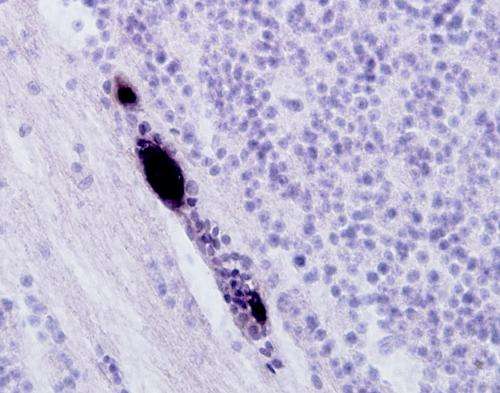Avian malaria also affects wild birds in Austria

Avian malaria is not uncommon in Central Europe, as many endemic wild birds are infected with species of Plasmodium, which cause avian malaria. In most cases these blood parasites, transmitted by mosquitoes, do not produce any symptoms in endemic birds, as they have adapted to the parasites. A team of pathologists at the Vetmeduni Vienna recently showed for the first time that native birds, too, are susceptible to avian malaria. The data collected was published in the journal Parasitology Research.
In the summers of 2001 and 2004, blackbirds died on a massive scale in Austria. At that time, researchers at the Vetmeduni Vienna analysed more than 600 deceased birds and identified the Usutu virus as the cause of death. The birds had been collected in a regional effort by Austrians and were handed over to the scientists at the Vetmeduni Vienna.
More than ten years later, the researchers tapped once more into the extensive sample material to test the birds that died back then for avian malaria. Until then, only birds kept at Austrian zoos and originating from countries without mosquitoes had been known to be affected by avian malaria. These types of birds at the zoo typically live in Antarctica and the far north, so they have not had the evolutionary opportunity to adapt to avian malaria.
"An infection is life-threatening for penguins at a zoo, for example," says lead author Herbert Weissenböck. "Native birds have adapted to the blood parasites over evolutionary time. Most of them carry the pathogen, but do not contract the disease. At least that's what we thought."
Avian malaria found in 15 percent of the examined birds
The researchers studied organs such as the liver, spleen, lungs and brain of 233 dead birds collected during the regional action programme. They found that some 15 percent of these specimens were infested with Plasmodium to such an extent that their organs were already damaged. Consequently, the researchers assume that the cause of these deaths was avian malaria.
Endemic populations of wild birds, however, are not at risk, believes Weissenböck. "Probably, only a small part of the population consistently dies of avian malaria. This has no dramatic effect on the overall population. But it is a completely new fact that native birds are susceptible at all."
Three different Plasmodium species identified
Around 100 different Plasmodium species are known to exist. Weissenböck and primary author Nora Dinhopl identified three species in the examined birds: P. elongatum, P. vaughani and a type related to the South American P. lutzi. This new species still needs to be analysed and classified. Surprisingly a fourth subspecies quite frequent in Central Europe, P. relictum, was not present in the dead animals. "It is possible that the P. relictum found thus far does not cause as severe symptoms. We attribute the deaths to the first three subgroups", Weissenböck reports.
Diagnostic method developed
Weissenböck and his team used a special RNA staining method that enabled them to examine the organs of dead birds. A special stain only binds to parasite RNA in tissue sections and therefore visualizes Plasmodium.
The pathologists want to further refine this method to be able to differentiate individual parasite subspecies. "Malaria is generally diagnosed in blood. Experts can see Plasmodium in red blood cells under the microscope. This was no option for the samples from our archives though. We would like to optimise our RNA staining process for blood samples as well. This would give us a sure-fire method for identifying different parasites in blood too", Weissenböck emphasises.
Plasmodium decimates mosquitos too
The parasite is also apparently problematic for mosquitos. In a recently published study, Lithuanian partners to the University of Veterinary Medicine Vienna demonstrated that a high load of Plasmodia is also lethal to the insects. (link.springer.com/article/10.1007%2Fs00436-013-3733-4 ). "This is probably one way the mosquito population is naturally reduced every year", says Weissenböck.
More information: "In situ hybridization and sequence analysis reveal an association of Plasmodium spp. with mortalities in wild passerine birds in Austria." Parasitology Research. link.springer.com/article/10.1 … 07/s00436-015-4328-z
Provided by University of Veterinary Medicine—Vienna


















